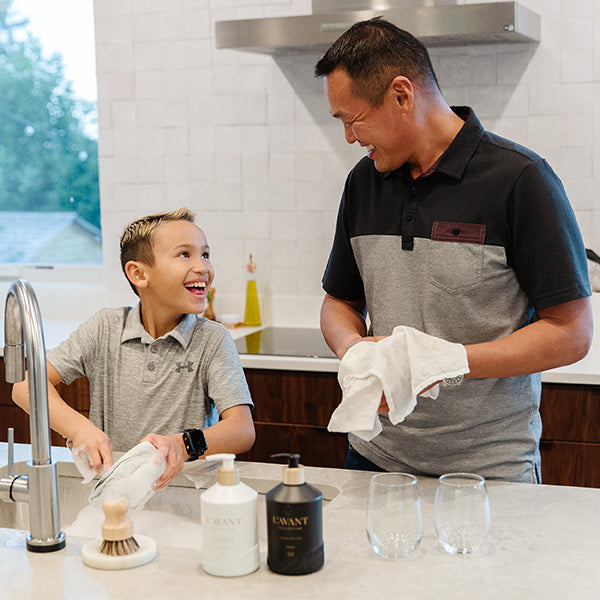Blog

We’ll let you in on a secret: non-toxic dish soap really can work as well as – and even better than! – its conventional counterpart. Getting rid of grease, leaving dishes sparkling clean, and not irritating your skin with harsh or questionable chemicals: Non-toxic dish soap really can deliver it all. And when you know what makes a good non-toxic dish soap, you’ll find that the best is found here at L’AVANT Collective. Get ready to learn what makes a natural dish soap highly effective, and why it’s such a great addition to your kitchen countertop.
Powerful surfactants
Surfactants are critical components of soap. According to the International Products Corporation, “The word surfactant means surface active agent. As the name implies, surfactants stir up activity on the surface you are cleaning to help trap dirt and remove it from the surface.” When there are a large number of surfactants present in a formula, they create a structure called a “micelle.” (You may recognize this term from the personal care product known as micellar water, often used as a makeup remover.) These micelles work together to remove dirt, soil, and grease from a surface.

When it comes to non-toxic dish soap, these surfactants can make all the difference in how they perform. Alkyl polyglucoside is a highly effective surfactant derived from coconuts, corn, or palm kernel oil. When paired with alkanoate salt, its solubility in water is improved, making it even more powerful against dirt, grease, and grime. These natural surfactants are a crucial part of our L’AVANT Collective High Performing Dish Soap. Not only are they non-toxic, but they really (really!) work to clean dirty dishes without compromising the health of your skin, your loved ones, or the environment.
A concentrated formula
What else makes a good non-toxic dish soap? A highly concentrated formula. Not only does a concentrated formula mean just a little of your non-toxic dish soap goes a long way, but the thick, concentrated formula of L’AVANT Collective eco-friendly dish soap adheres well to your sponges, brushes, and dishes, ensuring it stays where you need it as it lathers instead of running down the drain. Plus, the more concentrated the formula, the more power it has to tackle dirty dishes.

Skin soothing ingredients
Plant-based, skin-soothing ingredients are also a key part of what makes a good non-toxic dish soap. No one wants dry, chapped hands after doing the dishes, so L’AVANT Collective formulas are infused with good-for-skin ingredients like aloe vera, glycerin, and soothing oils of lavender, geranium, and lemon. Together, these natural dish soap ingredients help attract and retain skin’s moisture and help to calm redness, soothe irritation, and leave dishes clean and hands comfortable.
Now that you know what makes a good non-toxic dish soap, you can choose the best non-toxic dish soap! With its signature Fresh Linen fragrance and a limited-edition Winter Fir fragrance, L’AVANT has a high performing dish soap for every countertop. And, because every bottle of L’AVANT Collective soap is housed in elegant, elevated packaging, you can enjoy the view of your non-toxic dish soap as much as you enjoy using it on your dishes!



